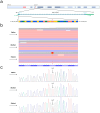Bioinformatic Evaluation of KLF13 Genetic Variant: Implications for Neurodevelopmental and Psychiatric Symptoms
- PMID: 39202416
- PMCID: PMC11354057
- DOI: 10.3390/genes15081056
Bioinformatic Evaluation of KLF13 Genetic Variant: Implications for Neurodevelopmental and Psychiatric Symptoms
Abstract
The Krüppel-like factor (KLF) family represents a group of transcription factors (TFs) performing different biological processes that are crucial for proper neuronal function, including neuronal development, synaptic plasticity, and neuronal survival. As reported, genetic variants within the KLF family have been associated with a wide spectrum of neurodevelopmental and psychiatric symptoms. In a patient exhibiting attention deficit hyperactivity disorder (ADHD) combined with both neurodevelopmental and psychiatric symptoms, whole-exome sequencing (WES) analysis revealed a de novo heterozygous variant within the Krüppel-like factor 13 (KLF13) gene, which belongs to the KLF family and regulates axonal growth, development, and regeneration in mice. Moreover, in silico analyses pertaining to the likely pathogenic significance of the variant and the impact of the mutation on the KLF13 protein structure suggested a potential deleterious effect. In fact, the variant was localized in correspondence to the starting residue of the N-terminal domain of KLF13, essential for protein-protein interactions, DNA binding, and transcriptional activation or repression. This study aims to highlight the potential involvement of the KLF13 gene in neurodevelopmental and psychiatric disorders. Nevertheless, we cannot rule out that excluded variants, those undetectable by WES, or the polygenic risk may have contributed to the patient's phenotype given ADHD's high polygenic risk. However, further functional studies are required to validate its potential contribution to these disorders.
Keywords: Krüppel-like factor; autosomal dominant inheritance; axonal growth; missense mutation; next-generation sequencing; transcription factors.
Conflict of interest statement
The authors declare no conflicts of interest.
Figures




References
MeSH terms
Substances
LinkOut - more resources
Full Text Sources
Medical
Research Materials

